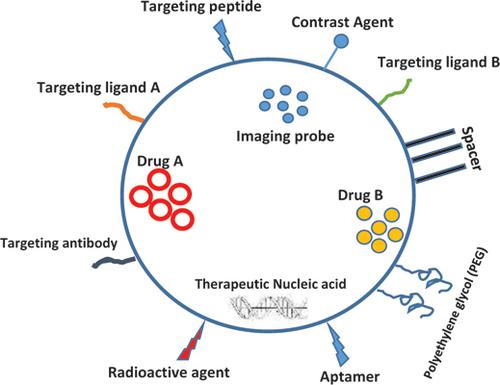Current Topics in Medicinal Chemistry ( IF 3.4 ) Pub Date : 2020-09-30 , DOI: 10.2174/1568026620666200825170030 Lina Lu 1, 2 , Shuhe Kang 1, 2 , Chao Sun 3 , Chufeng Sun 1, 2 , Zhong Guo 4 , Jia Li 1, 2 , Taofeng Zhang 5 , Xingping Luo 1, 2 , Bin Liu 5

|
Nanotechnology has revolutionized cancer treatment in both diagnosis and therapy. Since the initial application of nanoparticles (NPs) in cancer treatment, the main objective of nanotechnology was developing effective nanosystems with high selectivity and specificity for cancer treatment and diagnosis. To achieve this, different encapsulation and conjugation strategies along with surface functionalization techniques have been developed to synthesize anticancer drugs loaded NPs with effective targeting to specific tumor cells. The unique physicochemical attributes of NPs make them promising candidates for targeted drug delivery, localized therapies, sensing, and targeting at cellular levels. However, a nanosystem for localized and targeted cancer managements should overcome several biological barriers and biomedical challenges such as endothelial barriers, blood brain barrier, reticuloendothelial system, selective targeting, biocompatibility, acute/chronic toxicity, tumor-targeting efficacy. The NPs for in vivo applications encounter barriers at system, organ, and the cellular level. To overcome these barriers, different strategies during the synthesis and functionalization of NPs should be adapted. Pharmacokinetics and cellular uptake of NPs are largely associated with physicochemical attributes of NPs, morphology, hydrodynamic size, charge, and other surface properties. These properties can be adjusted during different phases of synthesis and functionalization of the NPs. This study reviews the advances in targeted cancer treatment and the parameters influencing the efficacies of NPs as therapeutics. Different strategies for overcoming the biological barriers at cellular, organ and system levels and biomedical challenges are discussed. Moreover, the applications of NPs in preclinical and clinical practice are reviewed.
中文翻译:

精密癌症治疗中的多功能纳米颗粒:纳米载体设计和功能化的考虑因素。
纳米技术在诊断和治疗方面都彻底改变了癌症治疗方法。自从纳米粒子(NPs)在癌症治疗中首次应用以来,纳米技术的主要目标是开发具有高选择性和特异性的有效纳米系统,用于癌症治疗和诊断。为了实现这一点,已经开发了不同的包囊和缀合策略以及表面功能化技术来合成负载NP的抗癌药物,其有效靶向特定的肿瘤细胞。NP的独特的理化特性使其成为有希望的候选药物,用于靶向药物递送,局部治疗,传感和靶向细胞水平。然而,用于局部和靶向癌症治疗的纳米系统应克服一些生物障碍和生物医学挑战,例如内皮障碍,血脑障碍,网状内皮系统,选择性靶向,生物相容性,急性/慢性毒性,靶向肿瘤的功效。用于体内应用的NP在系统,器官和细胞水平遇到障碍。为了克服这些障碍,应在NP合成和功能化过程中采用不同的策略。NP的药代动力学和细胞摄取在很大程度上与NP的理化特性,形态,流体动力学尺寸,电荷和其他表面性质有关。可以在NP合成和功能化的不同阶段调整这些属性。这项研究回顾了靶向癌症治疗的进展以及影响NPs治疗效果的参数。讨论了在细胞,器官和系统水平上克服生物障碍以及生物医学挑战的不同策略。此外,综述了NP在临床前和临床实践中的应用。



























 京公网安备 11010802027423号
京公网安备 11010802027423号